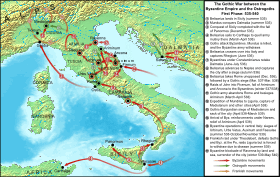535
| Millennium: | 1st millennium |
|---|---|
| Centuries: | 5th century – 6th century – 7th century |
| Decades: | 500s 510s 520s – 530s – 540s 550s 560s |
| Years: | 532 533 534 – 535 – 536 537 538 |
| 535 by topic | |
| Politics | |
| State leaders – Sovereign states | |
| Birth and death categories | |
| Births – Deaths | |
| Establishment and disestablishment categories | |
| Establishments – Disestablishments | |
| Gregorian calendar | 535 DXXXV |
| Ab urbe condita | 1288 |
| Assyrian calendar | 5285 |
| Bengali calendar | −58 |
| Berber calendar | 1485 |
| Buddhist calendar | 1079 |
| Burmese calendar | −103 |
| Byzantine calendar | 6043–6044 |
| Chinese calendar | 甲寅年 (Wood Tiger) 3231 or 3171 — to — 乙卯年 (Wood Rabbit) 3232 or 3172 |
| Coptic calendar | 251–252 |
| Discordian calendar | 1701 |
| Ethiopian calendar | 527–528 |
| Hebrew calendar | 4295–4296 |
| Hindu calendars | |
| - Vikram Samvat | 591–592 |
| - Shaka Samvat | 457–458 |
| - Kali Yuga | 3636–3637 |
| Holocene calendar | 10535 |
| Iranian calendar | 87 BP – 86 BP |
| Islamic calendar | 90 BH – 89 BH |
| Julian calendar | 535 DXXXV |
| Korean calendar | 2868 |
| Minguo calendar | 1377 before ROC 民前1377年 |
| Seleucid era | 846/847 AG |
| Thai solar calendar | 1077–1078 |
| Wikimedia Commons has media related to 535. |

The Gothic War: Belisarius subdues the Goths
Year 535 (DXXXV) was a common year starting on Monday (link will display the full calendar) of the Julian calendar. At the time, it was known as the Year of the Consulship of Belisarius without colleague (or, less frequently, year 1288 Ab urbe condita). The denomination 535 for this year has been used since the early medieval period, when the Anno Domini calendar era became the prevalent method in Europe for naming years.
Events
By place
Byzantine Empire
- Gothic War: Emperor Justinian I appoints Belisarius commander-in-chief (stratēgos autokratōr) and sends a Byzantine expeditionary force of only 8,000 soldiers (half are heavy East Roman cavalry) to begin the reconquest of Italy.[1]
- Summer – Belisarius lands in Sicily and meets little opposition, save for the Gothic garrison of Palermo. Laying siege to the citadel, he blockades the harbour with his ships. Mundus invades Dalmatia and captures its capital, Salona.
- Justinian I issues the Lex Julia and declares that a wife has no right to bring criminal charges of adultery against a husband. This makes divorce almost impossible in the Byzantine Empire.
- December 31 – Belisarius completes the conquest of Sicily, defeating the Gothic garrison of Palermo (Panormos), and ending his consulship for the year.
Europe
- April 30 – King Theodahad revenges himself upon queen Amalasuntha. He has her taken from the capital of Ravenna to a small island on Lake Bolsena, where she is strangled in her bath.[2]
- The Byzantine city of Justiniana Prima is founded and becomes later an bishop's seat of the Central Balkans.
Africa
- Spring – Solomon defeats the Moorish rebels at Mount Mammes and Mount Bourgaon. He secures Byzacena (modern Tunisia) and establishes fortifications along the Numidian border.
- April – Justinian I reorganises the province in an African prefecture, centered in Carthage. Restoring frontier defences, and returns property to the Catholic Church.[3]
Asia
- The Northern Wei Dynasty ends: The northern region of China is during a civil war split into the Eastern Wei and the Western Wei. The first ruler is Wen Di, he creates his son Fei Di crown prince.
- Significant to the history of agriculture, Chinese author Jia Sixia writes the treatise "Chimin Yaoshu" in this year, and although it quotes 160 previous Chinese agronomy books, it is the oldest existent Chinese agriculture treatise. In over 100,000 written Chinese characters, the book covers land preparation, seeding, cultivation, orchard management, forestry, animal husbandry, trade, and culinary uses for crops.
- Reports of the eruption of Krakatoa (Java), which possibly lead to several years of climate change (see Climate changes of 535–536), are recorded in the Javanese Book of Kings.
By topic
Religion
- May 8 – Pope John II dies in Rome after a 2-year reign and is succeeded by Agapetus I as the 57th pope. He is send on an embassy to Constantinople.[4]
- Byzantine troops drive the extremist Monophysite party out of Alexandria and establish Theodosius I as patriarch of the Eastern Orthodox Church.
- Anthimus I becomes patriarch of Constantinople from (535–536).
- A Christian basilica is completed at Leptis Magna in North Africa.
Meteorology
- The weather is reported to be unusually cold and dark in multiple parts of the world; see climate changes of 535–536.
Births
- Evagrius Scholasticus, Syrian scholar (approximate date)
- Sigebert I, king of Austrasia (approximate date)
- Theudebald, king of Austrasia (approximate date)
- Tiberius II Constantine, Byzantine Emperor (d. 582)
- Xiao Zhao Di, emperor of Northern Qi (d. 561)
Deaths
- April 30 – Amalasuntha, queen of the Ostrogoths
- Eugippius, disciple and biographer (approximate date)
- June 5 – Epiphanius, patriarch of Constantinople
- May 8 – Pope John II
- Timothy III, Coptic Orthodox Patriarch of Alexandria
- Xiao Wu Di, emperor of Northern Wei (b. 510)
- Xie He, Chinese writer and art historian (approximate date)
- Xu Mian, official of the Liang Dynasty (b. 466)